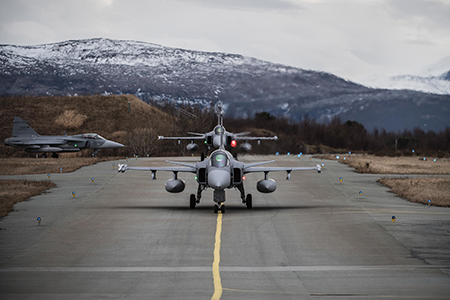NATO, Russia Conduct Nuclear Exercises Amid Rising Tensions
November 2025
By Shaghayegh Chris Rostampour
NATO and Russia conducted separate nuclear-related exercises in October amid heightened tensions driven by Moscow’s prolonged war with Ukraine and recent alleged incursions by both sides into each other’s territories. (See ACT, October 2025.)

NATO held its annual nuclear exercise, “Steadfast Noon,” Oct. 13-24, focusing on procedures for securing and preparing nuclear weapons for potential deployment. According to NATO Secretary-General Mark Rutte, the two-week exercise aimed to ensure that the alliance’s nuclear deterrent remains “as credible, and as safe, and as secure, and as effective as possible.” He added in his Oct. 13 announcement that Steadfast Noon “sends a clear signal to any potential adversary that we will and can protect and defend all allies against all threats.”
The exercise involved 14 of NATO’s 32 member states, which contributed about 70 aircraft and 2,000 personnel operating out of airbases in Belgium, Denmark, the Netherlands, and the United Kingdom, as well as the airspace over the North Sea. Although the training did not include live nuclear weapons, it involved dual-capable fighter jets certified to carry nuclear gravity bombs, as well as conventional support assets to simulate a nuclear scenario.
“These are conventional aircraft or other capabilities that can be used as part of a nuclear mission,” Jim Stokes, the director of NATO’s Nuclear Policy Directorate, said in a statement. “And this demonstrates the overall contribution that allies make, how we share the nuclear burden in different ways, and it really shows the unity we have at the alliance on nuclear issues.”
The exercise featured 13 different types of air assets, including dual-capable fifth-generation fighter jets, surveillance and reconnaissance assets, and refueling aircraft. The United States participated in the drills with four F-35s jets, which for the first time took a leading role as dual-capable aircraft in the “strike package” of the exercise, a term used to describe the simulation of a nuclear strike.
The drill also saw first-time participation by Finland and Sweden, marking a significant step in their integration into NATO’s nuclear planning framework following their respective accession to the alliance in 2023 and 2024. (See ACT, April 2024.) Sweden’s contribution included Gripen fighter jets providing conventional air support, a move that NATO officials said strengthens interoperability and bolsters the alliance’s broader deterrence posture. Finland contributed FA-18 Hornet fighter aircraft and staff officers.
An Oct. 13 NATO press release emphasized that Steadfast Noon is a “routine, long-planned training activity” and “not linked to any current world events.” However, Konstantin Kosachev, deputy chairman of the Russian Federation Council, described it as an “extremely dangerous development.” He told the Russian newspaper Izvestia that the maneuvers can “provoke reactions and retaliatory steps … not only from Russia.”
Meanwhile, Russian armed forces conducted their annual strategic nuclear exercise, dubbed “Grom,” Oct. 22 with land, sea, and air components. Gen. Valery Gerasimov, the chief of the general staff, said in a video report addressing Russian President Vladimir Putin, that the exercises would “practice the procedures for authorizing the use of nuclear weapons” and take a more offensive approach than last year’s exercise, which simulated a “massive nuclear strike in response to a nuclear strike by an adversary.”
Russian media broadcasted the launch of a land-based Yars intercontinental ballistic missile and a Sineva ballistic missile fired from a nuclear-powered submarine. Tu-95MS long-range bombers also fired air-launched cruise missiles, according to a statement by the Russian defense ministry.
Putin, who oversaw the exercise from the National Defense Control Center, emphasized that the maneuvers were scheduled in advance. However, tensions between NATO allies and Russia have been high on several fronts. Moscow recently accused NATO members of direct attacks on Russian territory; NATO has complained of Russian incursions into allied airspace. (See ACT, October 2025.)
U.S. President Donald Trump said recently that he expected to hold a summit with Putin in Budapest, but the meeting appears to be on hold.
